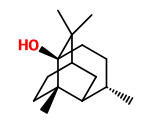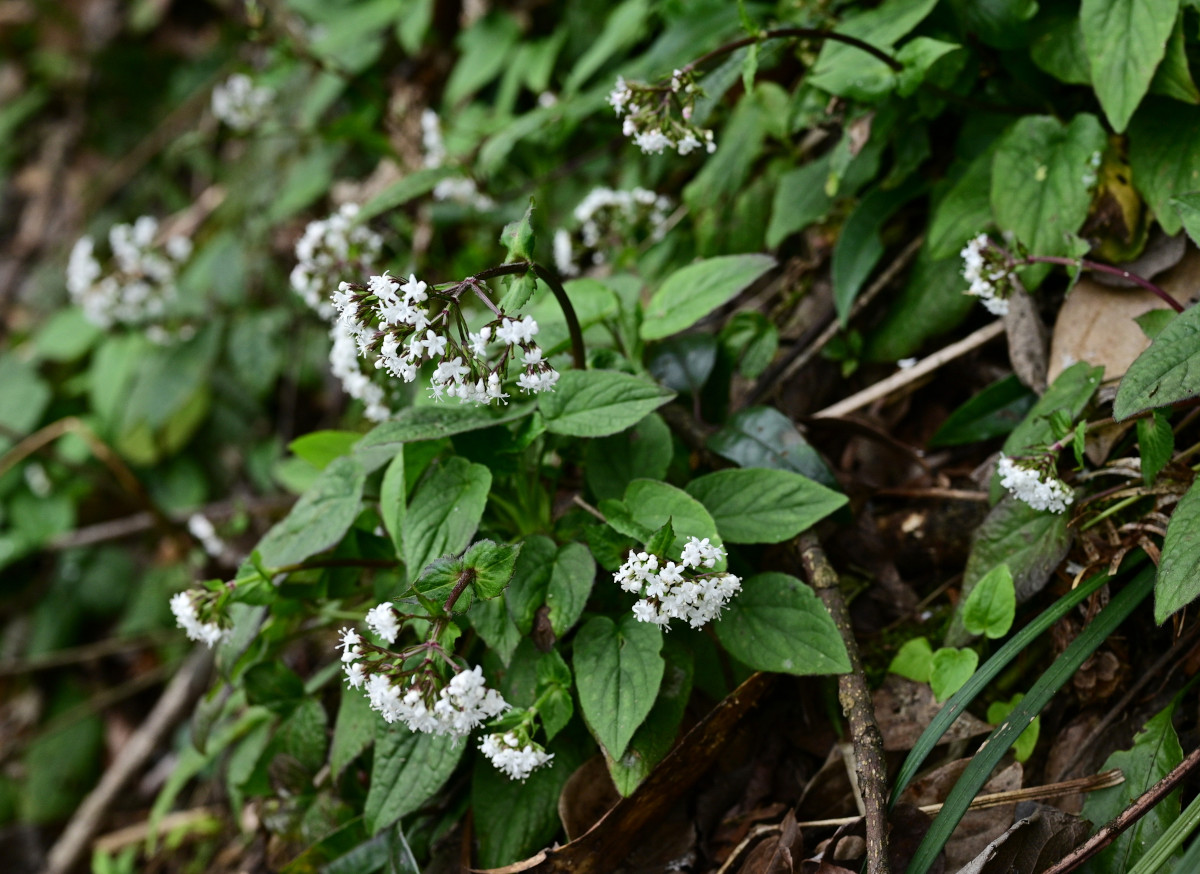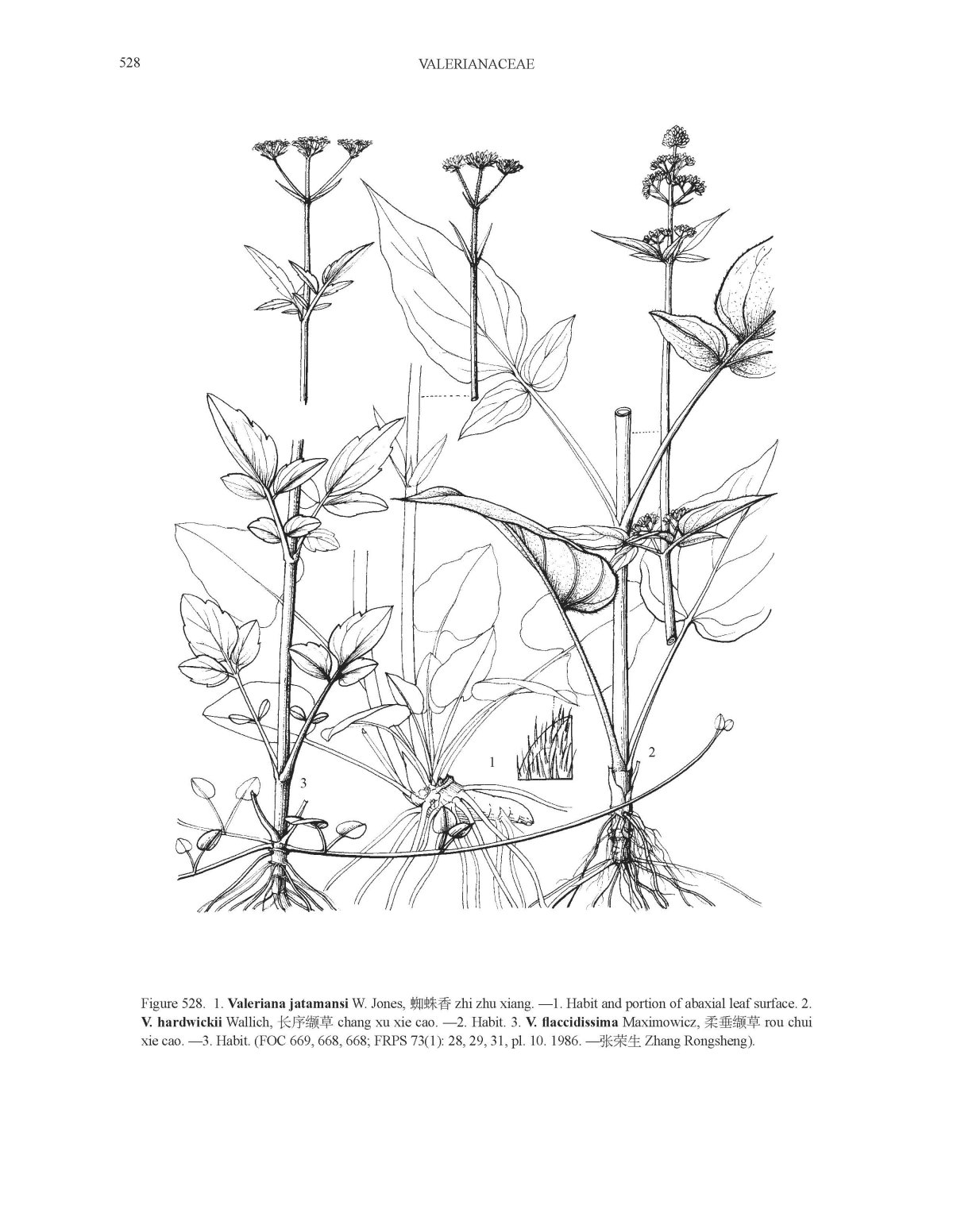Valeriana jatamansi Jones - syn. Valeriana wallichii DC.; Valeriana harmsii Graebn.; Valeriana mairei Briq. - Valerianaceae
蜘蛛香 zhi zhu xiang (chin.), Indian valerian, Indischer Baldrian
Perennial herb, 20-70 cm tall, native to Bhutan, India, Nepal, Northern Thailand, Vietnam; rhizomes short, robust, 0.5-2 cm in diam., nodes crowded; roots fibrous; stems 1 to several, erect, glabrate to pubescent, more densely so at nodes; basal leaves persistent, rosulate; petiole 4-10 cm; blade simple, cordate to cordate-ovate, 2-14 × 3-10 cm, hispidulous or glabrous, margin irregularly crenulate, crenate, or dentate, apex acute; cauline leaves in 2 or 3 pairs, sessile or subsessile, 1-3 cm, simple or trifoliolate; lateral lobes reduced; terminal lobe ovate; inflorescence corymbiform, villous at nodes; corolla white or pinkish, funnelform; flowers polygamous; bisexual flowers 3-4 mm, female flowers ca. 1.5 mm, stamens and style exserted; achenes narrowly ovoid, 2-2.5 × 1-1.5 mm, both sides villous.
http://www.efloras.org/florataxon.aspx?flora_id=2&taxon_id=200022557
„V. jatamansii is indigenous to the Chinese Himalayas. Geographically, it is distributed from Afghanistan, Kashmir, North-west India, Nepal, Sikkim, North-east India, Bhutan and Myanmar to SW China. It is found within an altitudinal range of 1500m to 3600m on north-facing moist forest bases and in open areas… The demand for Sugandhawal rhizomes and Valerian oil is very high in India and Pakistan. It has been estimated that about 100 tonnes of Sugandhawal rhizomes is harvested annually from Nepal… The global status of Sugandhawal is not known. It is considered to be vulnerable in Nepal (CAMP 2001). Commercial collection of rhizomes for trade poses great threat to its sustainability in the wild.“
[Pyakurel, Dipesh, and Ashok Baniya. NTFPs, impetus for conservation and livelihood support in Nepal. WWF Nepal, 2011, 98-103]
„Indian valerian root oil obtained from the roots of the plant V. wallichi collected from different areas has been examined. Neutral portion of the oil contains ar-curcumene, α,β,γ-patchoulenes, patchouli alcohol, β-sitosterol, valeranone, maali-oxide, maaliol, calarene, and the new sesquiterpene hydrocarbon β-bergamotene which is an isoprenologue of β-pinene. Acidic portion of the oil is composed of formic, propionic, butyric, isovaleric, β-methyl valeric, palmitic, steric acids, and isovaleryl ester of α-hydroxyisovaleric acid along with some unidentified acids.“
[Terpenoids-XLVI : Components of Indian valerian root oil. C.S. Narayanan, K.S. Kulkarni, A.S. Vaidya, S. Kanthamani, G.Lakshmi Kumari, B.V. Bapat, S.K. Paknikar, S.N. Kulkarni, G.R. Kelkar, S.C. Bhattacharyya, Tetrahedron Vol.20 (4) 963-968 (1964)]
 (-)-patchoulol (patchouli alcohol)
(-)-patchoulol (patchouli alcohol)
„The volatile constituents isolated from roots and rhizomes of Valeriana wallichii DC. ( = V. jatamansi Jones) were investigated by GC and GC-MS (EI and NICI) analysis. The plant material was obtained from different sources, namely from a local market in Kathmandu (Nepal), from plants grown in The Netherlands and in Germany, and from commercially available material from several German importers. The various roots and rhizomes yielded between 0.09 and 1.30% (v/w) essential oil on a dry weight basis. The main constituents of the oils from the plants grown in Europe were an unidentified sesquiterpene hydrocarbon, α-santalene, ar-curcumene and xanthorrhizol. In the oils from the Nepalese material and from the commercially available roots, except in one sample, patchouli alcohol was the main component.“
[Composition of the Essential Oil from Roots and Rhizomes of Valeriana wallichii DC., Rein Bos, Herman J. Woerdenbag, Henk Hendriks, H. Friso Smit, Håkan V. Wikström and Johannes J. C. Scheffer, Flavour and Fragrance Journal, 1997, Vol.12 (2) 123-131]
The chloroform extract of V. wallichii roots showed antileishmanial activity, one active ingredient found was caffeic acid bornyl ester.
[Glaser, Jan, et al. „Antileishmanial lead structures from nature: Analysis of structure-activity relationships of a compound library derived from caffeic acid bornyl ester.“ Molecules 19.2 (2014): 1394-1410] http://www.mdpi.com/1420-3049/19/2/1394/htm
The major compounds identified in V.jatamansi root oil by GC and GC-MS were patchouli alcohol (0.4-63.7%), maaliol (2.9-53.8%), seychellene (4.1-27.4%), calarene/ß-gurjunene (3.0-20.8%), and α-santalene (0.6-12.0%). Minor constituents were bornyl acetate (0.6-1.5%), α-guaiene (0.7-2.3%), α-bulnesene/δ-guaiene (0.7-6.3%), 7-epi-α-selinene (0.4-1.4%), kessane (2.1-3.3%), spathulenol (0.7-3.4%), viridiflorol (0.9-7.1%), α-patchoulene (0.8-6.6%), and ß-patchoulene (0.4-0.8%).
[Raina, Archana P., and K. S. Negi. „Essential oil composition of valeriana jatamansi jones from himalayan regions of India.“ Indian journal of pharmaceutical sciences 77.2 (2015): 218] https://www.ncbi.nlm.nih.gov/pmc/articles/PMC4442472/

Valeriana jatamansi, Qianxinan Buyei and Miao, Guizhou, China (2024) © 江国彬 CC BY-SA 4.0 inaturalist.org

Valeriana jatamansi (1) in: Flora of China
